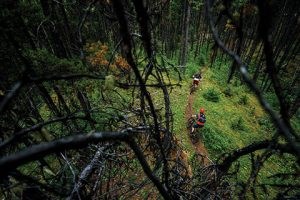
You remember that feeling as a kid, that uh-oh-here-it-comes gut drop when youāre about to be spanked? Thatās how I feel right now. Iām out for an evening rip with one of Jasperās XC nerds, Matt Staneland, who, to my concern, is riding a svelte 19-inch Kona Unit hardtail, ideal for smashing out big miles on the sprawling network of cross-country trails in Jasper National Park.
The setting sun casts an amber glow upon Roche Bonhomme, the distinctive ridgeline east of town that resembles an old duffer in repose. Jasper is like a mini-Banff, set in a mountain valley where the Athabasca and Miette rivers meet, a setting that has sent infinite camera shutters clicking since it morphed from a rough railroad siding into a tourist haven following the creation of Jasper Forest Park in 1907. However, for mountain bikers, the similarities between Jasper and Canadaās other national parks end quickly.
Canadian national parks, in my book, are dead zones for mountain biking, places where our sport ranks in importance well below hiking, horseback riding and maybe even pickleball playing; itās treated like that unpredictable second cousin with a gift for the off-colour joke who gets the obligatory invite to family reunions. Or so I thought, until I heard rumours of epic XC riding in Jasper, where mountain biking is not only allowed on almost every official lower-elevation trail, itās encouraged. Proactive, enterprising cyclists have somehow found a way to work with the plodding bureaucracy of Parks Canada, the federal agency responsible for national parks, where decision-making often creeps along at a glacial pace.
But thereās nothing glacial about Stanelandās pace. We rip northward along Big Horn Alley, a smooth, hard-packed route on a grassy bench above the Yellowhead Highway, passing a couple of tourists on road bikes looking stunned and lost on the side of the trail. Dark clouds stack forebodingly on the horizon. After dodging transport trucks at the highway crossing, we join Trail 7, which quickly devolves into a grunty, rooty and rocky ascent up to the Maligne Canyon parking lot. We coast across the deserted parking lot then grab dry Trail 7h, its surface skittish with ball-bearing pebbles, that contours above a deep limestone gorge to a high point with a panoramic view of the Athabasca Valley. It occurs to me that these trail names (7, 7h, etc) are the definition of dull considering the stunning setting in which the trails they describe are found. Itās a nomenclature that drives Staneland nuts. A decade ago he moved to Jasper from Ontario and landed a job at Marmot Basin, the local ski hill. It was enough to pay for beer, pizza and rent. A few years ago, Staneland upgraded to more gainful employment with the Canadian National Railway Company as a signals and communication specialist.
āBasically my job is to keep things moving,ā Staneland explains. The same could be said of his role in the local mountain biking community. Five years ago he helped form the Jasper Cycling Association in response to Parks Canadaās sudden decision to close a popular mountain biking area east of town due to wildlife concerns.
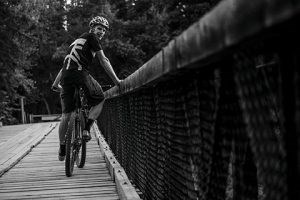
āWe needed to keep Parks Canada on track so they wouldnāt just close areas to mountain biking at random and without consulting us,ā Staneland says, referring to a planning document called the Three Valley Confluence that was established in an effort to avoid such conflict.
Itās another example of the constant push, pull and compromise that keeps riding alive in this 11,000-square-kilometre national park. Without a doubt, what Jasper cyclists have created within the tightly regulated regime of a national park, where not a spoonful of dirt gets moved without an environmental impact assessment first, is remarkable. Roughly 300 kms of trail are open to cycling, ranging from wide gravel paths linking the town with local campsites that you could shred on a beach cruiser, to wiggly, technical cross-country singletrack scraped together from game trails, longer point-to-points such as the Overland Trail and farther-flung circuits like The Saturday Night Lake Loop. But to the outsider, mountain biking in Jasper can seem quirky, even confusing. Thatās because the network is divided into three categories: trails we can shout about, trails we can talk about quietly and trails we canāt even whisper about. The first category includes ones maintained by Parks Canada and found on official park trail maps that are identified by that confusing matrix of trail numbers. The second is the Wildland Trails, roughly 15 of them, with enticing names like Magic Ridge and Razorback built and maintained by mountain bikers (up until last summer parks management had enforced a Trailforks embargo on Wildland Trails to minimize traffic, meaning you needed to be Sherlock Holmes to find them.) The Wildland Trails are to the overall trail network what the filling is to the pie; without them, you have a lot of crust. Finally there are unofficial trails that locals ride regularly without parks endorsement, some of which they hope will eventually get adopted into the network. For advocates like Staneland, this quasi-secret trails society for locals has been a historical point of frustration.
āJasper is really missing an opportunity to promote this area,ā Staneland says. āBut this is also a good news story. After all weāre riding our mountain bikes in a national park.ā

The following day, I set out to learn more about this good news story and find Loni Klettl, someone who was spinning knobby tires around Jasper long before Staneland moved here, when mountain biking was fringe. As a founding member of the Jasper Trails Alliance, a volunteer group that represents all trail users, she hammered away in the late 1980s and early ā90s at staunch traditionalists like Ben Gadd, a legendary local parks naturalist, who was not alone in making mountain bikers feel about as welcome in Jasper as a bagpiper in a monastery. At the time, parks bureaucracy was dominated by people who didnāt understand the sport, an institutional attitude confirmed by a 2001 York University study that concluded national parks are āreacting to problemsā instead of developing proactive management policies, despite mountain biking having been around in parks since the early ā80s. I meet Klettl in her tidy bungalow tucked a few blocks away from the summertime RV traffic jams. Her father was a German immigrant who came to Canada after surviving the Second World War in Russia, and eventually became a Jasper park warden, where Klettl grew up skiing Marmot Basin. She made the Canadian national team, and raced at the 1980 Lake Placid Olympics when the āCrazy Canucksā were the toast of the downhill World Cup circuit. Post ski racing she returned to Jasper to settle in the family home, ride her bike, ski tour, trail run and hike in her wilderness surroundings.
Klettl is slight for an ex-downhill skier, with ropy, muscular legs and forearms. I fear she could not only slay in arm wrestling but also demolish me if I stood between her and a mountain bike ride. Klettl hustles around the kitchen, brewing espresso and filling water bottles, then leads me to an adjoining room where she stores trail maintenance equipment, including an electric chainsaw, an arsenal of hand tools and a box full of plastic yellow diamonds used for marking trail.
āThey call me Loni on the trail with diamonds,ā she says with a coy smile, then adds suddenly. āDo you mind if we ride and talk?ā
Jasper is well suited to people like Staneland and Klettl, riders who love to pedal ad infinitum. Around here, you can crush 10 trail miles before youāve even crushed the morning caffeine buzz. Itās a sprawling cycling landscape that has also spawned one of Canadaās
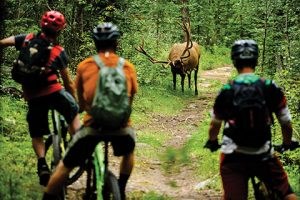
top marathon XC talents, Cory Wallace, the Jasperite who rides for the Kona Factory Team and clinched the podium at last Decemberās Yak Attack in Nepal. Klettl and I are bound for a Jasper XC classic, the 20-mile Saturday Night Lake Loop. Hopes of a mellower pace than Stanelandās are dashed as soon as we begin pumping up Trail 2 through fragrant forest to gain the bench west of Jasper. We spin along Cabin Lake Fire Road for 10 minutes, before exiting onto Trail 8, or the Mina Riley Loop, which allows us to skirt around a dam upgrade construction site on Cabin Lake. In 15 minutes we regain the Saturday Night Lake Loop. Klettl drops the hammer on a seasoned, natural trail of compact dirt and rock slabs that winds through trembling aspen and conifer. The deeper we travel west into the park, the more lush, cooler and wilder it feels. We stop to fill water bottles next to a cascade that tumbles over a cliff covered in electric-green moss. I examine some of the first trail woodwork Iāve encounteredāa greasy, semi-decomposed and neglected boardwalk with a minefield of exposed rusty red nail heads. Itās obvious Parks Canada doesnāt spend much of its trail budget on remote trails like this, and this frustrates some locals. Yet Klettl is the perpetual optimist.
āI think the mountain bike relationship with Parks Canada is strong. Whatās cool is that almost every trail in Jasper Park is a multi-use trail. And I tell people, if they donāt like it get used to it,ā Klettl says.
A boggy section slows us temporarily. The mosquitoes are suddenly ferocious but we find relief when we reach the outer apex of the loop and begin a fast descent through dry forest back toward town. We finish on a favorite Wildland Trail, Ganges, that has the stamp of something built by riders, for riders. I work my bike along the thinly treed ridge, linking stretches of exposed bedrock with tight, neatly bermed corners. Occasionally my tires splash through depressions where rainwater pooled following the previous nightās violent thunderstorm.
A few days later, Iām chasing local artist and rider Tristan Overy up Magic Ridge, one of those Wildland Trails that up until a year ago you couldnāt find on Trailforks. It angles uphill off Trail 3, where it skirts the shore of Marjorie Lake, and itās steep and techie. Overy ascends like a mountain goat, intimately familiar with each rock step-up, knowing when to snatch rests before the next mini crux. I struggle to keep the front wheel weighted, momentarily cursing my slack, six-inch-travel bike. My heart feels like itās about to implode by the time we have grinded to the top of the ridge, and pause to soak in Mount Edith Cavellās stunning north face. I follow Overy down a roller coaster of cheese-grater-coarse limestone, steering away from a tire-swallowing channel that cleaves the rock slab like a butt crack, then we launch a hip-height drop onto soft pine needles; this is the magic of Magic Ridge. Itās not long before weāre back on cruisy Trail 3 and being blocked by a bull elk with a chandelier of a rack, browsing willows along the trail. We wait at a safe distance and the conversation drifts toward the politics of mountain biking in Jasper. As in any local riding scene, there are players who view government land managers as an enemy of their sport. They eschew advocacy and simply ride and build trail wherever they want, poaching classics like the Skyline trail, which used to be unofficially open for riding until Parks began enforcing a permanent closure to mountain bikers, preserving the popular alpine route for hikers. There are even some Parks Canada employees who build renegade trail in their off hours.
āMost of the trails built by mountain bikers eventually get adopted into the network,ā Overy says. āI know some people think Loni plays both sides a little too much. Yet she is the one out there working on trail and putting in the volunteer hours. If someone is going to criticize then doesnāt lift a finger, itās not worth much.ā
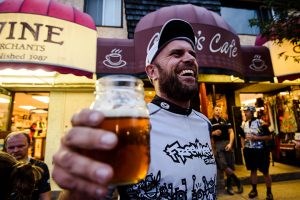
That afternoon I hang out with Chris Peel, who owns Freewheel Cycle with his wife, while one of his mechanics diagnoses my bikeās creaky rear hub. Peel believes strongly that Jasper has world-class cross-country riding and that Parks Canada has come a long way to accommodate mountain bikers. However he admits marketing the goods to out-of-towners isnāt easy, given that trails found on official maps only scratch the surface of whatās available, and Parks prohibit local shops and clubs from hosting mountain bike races.
āPeople pile through here with bikes in trucks on their way to somewhere else. People are wanting flow trails and machine-built trails, but I think riders are missing out on the fun and challenge of the natural trails that we have,ā Peel says.
Though dogged advocacy is at the root of Jasperās mountain biking riches, its natural topography of open valleys and rolling terrain conducive to trail building has also helped foster a strong mountain biking culture. Managing a national park is a constant balancing act between access and conservation. Parks Canada has a legislated mandate to preserve ecological integrity while enhancing opportunities for Joe public to enjoy the outdoors, but has stated in strong terms that it has no plans to green-light any new trail building in the valleys around Jasper. At the same time, Klettl and Staneland are pushing hard to have some commonly ridden, rogue trails that drop off the Marmot Basin access road and a few other popular routes sanctioned as Wildland Trails.
āWeāre not Squamish or Revelstoke and weāre not trying to be. Our offering is not black diamond trails, itās using two wheels to explore the park,ā Rogier Gruys, Jasper parkās visitor experience and product development specialist, tells me one afternoon while he sips coffee and I drink a Blue Buck beer at Cocoās Cafe, a favorite post-ride hangout. Outside a parade of tourists flows along the sidewalk bound for a requisite selfie with the town mascot statue, Jasper the Bear.
According to Gruys, mountain bikers represent a small proportion of the two million tourists who visit Jasper annually, but he admits Jasper doesnāt have a good handle on how many people are choosing to experience the park from the seat of a mountain bike. So how can you truly optimize mountain biking opportunities without knowing how much two-wheeled traffic the park attracts? Gruys says itās a budget thingāthereās no money to gather that data.
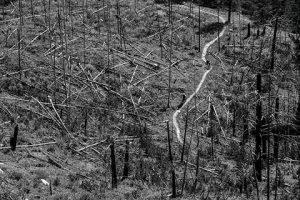
A similar movement is happening south of the Canadian border as well, where U.S. national park managers, facing declining visitor numbers and strapped budgets likely destined for more decimation under the current presidential administration, are increasingly opening select trails to mountain bikes to attract new visitors.
Declining visitation is not an issue in Jasper, as witnessed by the crowd jostling for takeout sandwiches one afternoon at the Patricia Street Deli. Itās the lunchtime rush, and when my number gets called, proprietor Glen Lietch, noticing my gear, seems to forget about his customers and launches into mountain bike banter. Leitch is a gregarious 61-year-old, with silver hair wrapped into an impressive man bun and a green T-shirt that says āWe Cycle.ā Like a lot of his riding buddies, he sees Jasper as an overlooked mecca.
āWeāre special,ā he says. āThe other national parks donāt have it figured out.ā
Beneath an intense July sun, I head out for Valley of the Five Lakes on Trail 9, a must-do XC outing for Jasper newbies, Iām told. Fifteen minutes after leaving the trailhead, where the turquoise Athabasca River roils below Old Fort Point, I arrive at a steep rocky climb that has only been cleaned once, by legendary Vancouver-based Kona rep Dickie Cox. The trail meanders up and down monotonously through the forest, making me wonder why this nondescript trail deserves classic status. I find out why when I reach the first of the five lakes and the trail narrows into a firm ribbon of alluvium contouring above pools of an astonishing shade of emerald. The riding is fast and flowy. I slow to pass a pair of cyclists, one of them wearing white sneakers, jeans and an Edmonton Eskimos cap. Farther on, a family of hikers jams the trail, the grandmother gripping a makeshift walking stick that is as tall as her 5-foot-2-inch frame. This is Jasper multi-use in all its glory; sometimes not pretty but laudable no less.

Itās 6 a.m. on my last day in the park. Jasperās streets are deserted and the valley is filled with a soft diffuse light. I grab a mountain-sized cinnamon bun from Bearās Paw Bakery and an Americano, then drive north on the Yellowhead Highway. A coyote lopes across the highway and vanishes into the forest. Morning mist hangs languidly over the Athabasca River. Twelve miles from town, I stop at a gravel pullout, shoulder my bike and scale a low-angled shale escarpment to the start of the Overlander trail. The air is brisk and still. My tires grip the limestone as I pedal slowly at first, spinning out the morning cobwebs. I pick up speed, where the trail traverses open talus, then I loop into a densely treed ravine before standing above the saddle for a quick burst uphill and back onto open mountain side. I revel in this solitary morning ride but the witching hour for wildlife encounters keeps me alert and a tad nervous, not unlike the pioneers who traveled this route heading west more than a century ago must have felt, long before roads and railways cut across the Rockies. Jasper has proven that not all national parks are dead zones for mountain biking. Itās not perfect, but at the end of the day local riders have something to boast about.
